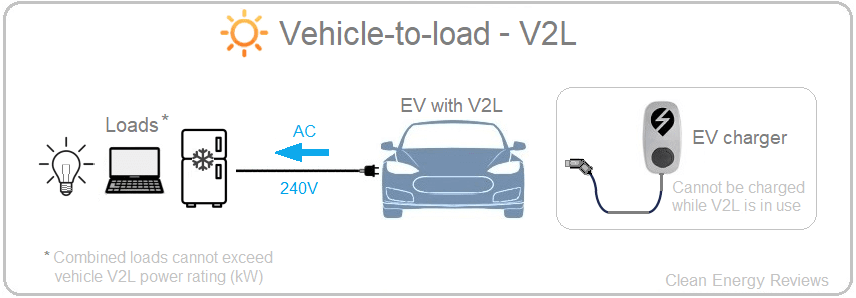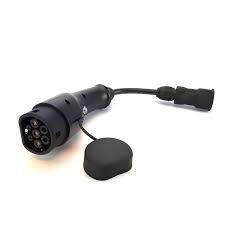Electric Vehicles (EVs) have a considerable battery storage system to extend their driving range, but what if you could use these batteries for more than just driving?
With bidirectional capable EVs, you can now use your EV batteries in more ways than one. Vehicle to Load (V2L) gives you autonomy during camping trips, power outages, and more, so that you can use the power from your car to power electrical appliances and more.
Here we will explain everything you need to know about bidirectional charging technology for V2L, including how the process works, how it differs from regular charging, which EVs include V2L capability, and the difference between V2L and V2H charging.
How Does Regular AC EV Charging Work?
Before diving into the explanation of bidirectional charging technology, it is important to fully understand how regular EVs charge in Australia with AC power. This is a pretty straightforward process.
For starters, the EV charging station will demand a certain amount of AC power from the home’s switchboard to provide it to the EV. The power rate of the EV charger is defined by the EV charging level and the design of the device. For instance, you could use a single-phase 7.2kW EV charger like the Ocular LTE or a three-phase 22kW EV charger like the Zappi or the Wallbox.
Since EV batteries don’t charge with AC power, this power has to be transformed from AC into DC; this is where the on-board AC charger installed on the EV comes in. The on-board charger converts AC power into DC at the right voltage and then sends it to the battery. The battery will require power until it is fully charged, then the charger will trickle charge it to keep it at 100% until it is disconnected.
What Is Bidirectional Charging?

Bidirectional charging technology makes it possible to use the energy stored in the battery in the opposite direction, so that instead of charging your battery, you’re pulling power from it to power appliances and more.
Bidirectional charging technology does require one vital thing: a bidirectional capable EV. Depending on the particular application, you might need an adapter to connect to the EV charging port and use a conventional 230V single-phase power outlet or a bidirectional capable EV charger. Sometimes your car will come with a typical power plug inside the car.
During bidirectional charging, DC power stored in the battery is converted into AC power by the on-board charger to then power any external appliances.
How Does V2L Work?
Vehicle to Load EV charging allows you to power virtually any appliance on the road, making it extremely useful to power coffee makers, electronic devices, and all types of appliances. This application is ideal for road trips, camping trips, and even an excellent option to power certain critical loads at home by using a power outage.

To power a load through Vehicle to Load EV charging you do not need a bidirectional capable EV charger, only a V2L adapter (see the image above). However, you need to make sure your EV has bidirectional capability first as plugging in that adapter in the image above would not work for all EVs.
This V2L EV charger is plugged into the EV charging port (usually Type 2 in Australia) and features a conventional single-phase 230V power outlet at the other end. You can use this power outlet to power all types of loads by using the DC stored energy of the EV that is being converted into AC power by the on-board charger.
Enjoying all the benefits of Vehicle to Load EV charging is a great way to be action-ready on the road and have energy autonomy from the grid. This is why you should pick an EV that features bidirectional capability.
What EVs Have V2L Capability in Australia?
See a list below of EVs as of Sept 2022 that have V2L/bidirectional capability. This list is not complete and if you are unsure, please check with us to see if your EV has this capability.
- Audi e-Tron SUV
- BMW i3
- Hyundai Ioniq 5
- Mitsubishi Outlander PHEV
- Mitsubishi Eclipse Cross
- Kia E-Niro
- KiaE EV6
- Nissan Leaf
- Porsche Taycan
As new EVs are being released to the Australian market, a higher number of EV models will feature bidirectional capability. If you own one of these EVs or are considering buying one of them, the next step is purchasing one of the best V2L EV chargers or adapters to enjoy this great application.
V2L vs. V2H Charging, What’s the Difference?
As great as V2L is, it is not the only bidirectional charging application. There is also V2H (Vehicle to Home), which is excellent and specifically designed to power your entire home. Many people get confused on the difference here, but V2L and V2H are very different.
In simple terms, the V2H capable car acts as a power supply for your entire house, just like the grid mains would be for your existing power supply. The only downside with V2H is that you cannot use a simple V2L adapter, instead, you need a bidirectional capable EV charger as well as an installed electrical infrastructure for the back-up panel.
Currently, the only EV charger in Australia featuring bidirectional technology is the Wallbox Quasar, but this will rapidly change as more and more charger manufacturers release bidirectional chargers.
revcharge is an end-to-end EV charging service provider. We take the stress and guesswork out of not only finding an EV charger that meets your needs, but that too of organising a trained technician to install and activate your system. Every EV charger on offer has been carefully evaluated for its performance and features by our specialised team.
Our goal is to save you time and money, while ensuring a quality install that will last you for years to come. All you have to do is answer some quick questions about your home and electric car and send us photos of your switchboard and preferred charger location. We’ll take care of the rest!
Learn more here and get an obligation-free quote today!